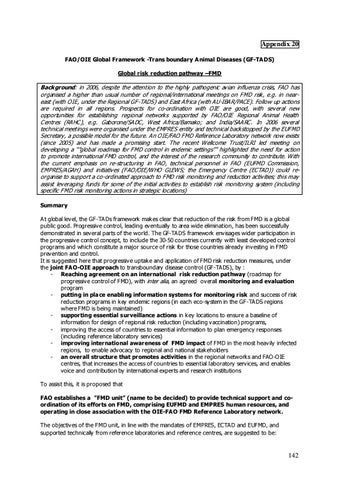Appendix 20 FAO/OIE Global Framework -Trans boundary A nimal Diseases (GF-TA DS) Global risk reduction pathway –FMD
Background: in 2006, despite the attention to the hig hly pathogenic avian influenza crisis, FAO has organised a higher than usual number of regional/international meetings on FMD risk, e.g. in neareast (with OIE, under the Regional GF-TADS) and East Africa (with AU-IBAR/PACE). Follow up actions are required in all regions. Prospects for co-ordination with OIE are good, with several new opportunities for establishing regional networks supported by FAO/OIE Regional Animal Health Centres (RAHC), e.g. Gaborone/SADC, West Africa/Bamako; and India/SAARC. In 2006 several technical meetings were organised under the EMPRES entity and technical backstopped by the EUFMD Secretary, a possible model for the future. An OIE/FAO FMD Reference Laboratory network now exists (since 2005) and has made a promising start. The recent Wellcome Trust/ILRI led meeting on developing a “”global roadmap for FMD control in endemic settings”” highlighted the need for action to promote international FMD control, and the in terest of the research community to contribute. With the current emphasis on re-structuring in FAO, technical personnel in FAO (EUFMD Commission, EMPRES/AGAH) and initiatives (FAO/OIE/WHO GLEWS; the Emergency Centre (ECTAD)) could reorganise to support a co-ordinated approach to FMD risk monitorin g and reduction activities; this may assist leveraging funds for some of the initial activities to establish risk monitoring system (including specific FMD risk monitoring actions in strategic locations) Summary A t global lev el, the GF-TA Ds framework mak es clear that reduction of the risk from FMD is a global public good. Progressiv e control, leading ev entually to area wide elimination, has been successfully demonstrated in sev eral parts of the world. The GF-TA DS framework env isages wider participation in the progressiv e control concept, to include the 30-50 countries currently with least dev eloped control programs and which constitute a major source of risk for those countries already inv esting in FMD prev ention and control. It is suggested here that progressiv e uptak e and application of FMD risk reduction measures, under the joint FA O-OIE approach to transboundary disease control (GF-TA DS), by : - Reaching agreement on an international risk reduction pathway (roadmap for progressiv e control of FMD), with inter alia, an agreed ov erall monitoring and evaluation program - putting in pla ce enabling information systems for monitoring risk and success of risk reduction programs in k ey endemic regions (in each eco-sy stem in the GF-TA DS regions where FMD is being maintained) - supporting essential surveillance actions in k ey locations to ensure a baseline of information for design of regional risk reduction (including v accination) programs, - improv ing the access of countries to essential information to plan emergency responses (including reference laboratory serv ices) - improving international awareness of FMD impact of FMD in the most heav ily infected regions, to enable adv ocacy to regional and national stak eholders - an overall structure that promotes activities in the regional network s and FAO-OIE centres, that increases the access of countries to essential laboratory serv ices, and enables voice and contribution by international experts and research institutions To assist this, it is proposed that FAO establishes a ”FMD unit” (name to be decided) to provide technical support and coordination of its efforts on FMD, comprising EUFMD and EMPRES human resources, and operating in close association with the OIE-FA O FMD Reference Laboratory network. The objectiv es of the FMD unit, in line with the mandates of EMPRES, ECTA D and EUFMD, and supported technically from reference laboratories and reference centres, are suggested to be:
142



